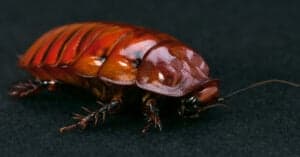One of the things that makes both fleas and ticks well-known is their status as pests, despite their differences. But would you be able to distinguish between these two pests? Probably not, but you’re not alone in that. It is difficult for many people to distinguish the differences between the two. You may be surprised to learn that fleas are tiny black bugs that jump and feed on blood, whereas ticks are brown or black and do not jump. The bites of these pests can cause a great deal of pain and irritation.
Furthermore, when you have a dog with you, you have a higher risk of encountering one of these tiny insects. Having a clear understanding of the differences between these two bugs is crucial since they can both spread diseases to you and your pets. Understanding the difference between them can help you better recognize them and keep you and your pet safe!
Below, we’ll look at the major differences between fleas and ticks. In this article, we will go over the differences in appearance, habitat, and even how they move around. By the time you finish reading this, you’ll know all the differences between the two!
Comparing Fleas vs Ticks
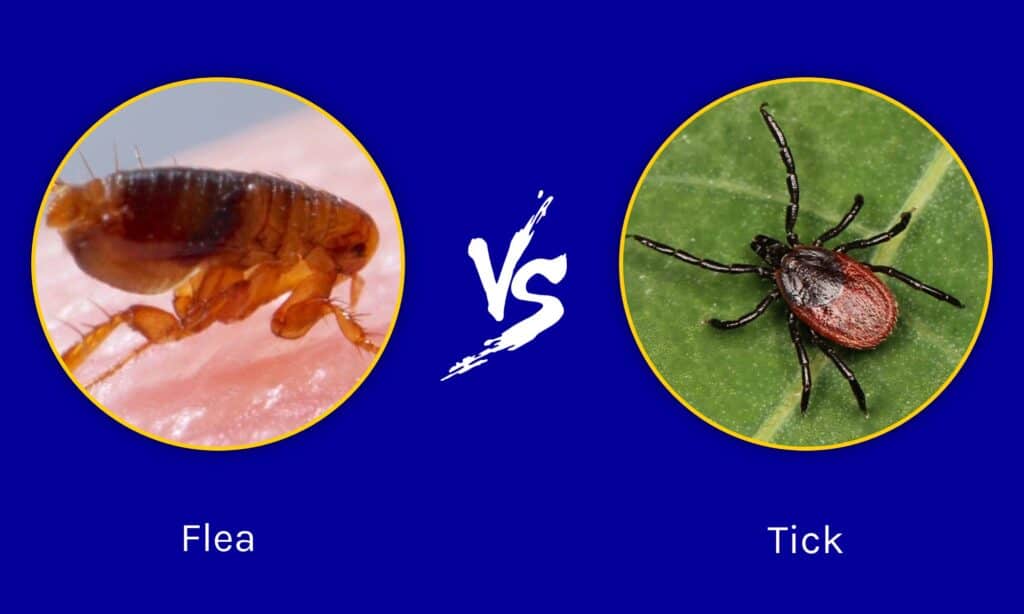
| Flea | Tick | |
|---|---|---|
| Taxonomy | Siphonaptera | Ixodida |
| Size | ⅛ of an inch long | 2 – 6 millimeters long when unfed, 10 millimeters when fed |
| Habitat | Areas with high humidity, moisture, and shade | Wooded and grassy areas |
| Color | Reddish-brown | Grayish-white, brown, black, reddish-brown, or yellowish |
| Active Season | Early spring, summer, and fall | April – September |
| Diseases Spread | Murine Typhus, Mycoplasma haemofelis, Tapeworms, Cat scratch disease | Lyme disease, Rocky Mountain Spotted Fever, Colorado Tick Fever, Tularemia, Bourbon virus |
| Lifespan | The lifespan of an adult flea is over 100 days | Ticks can live anywhere from a few weeks to 3 years |
The Key Differences Between Fleas and Ticks
The flea is a small, wingless insect that feeds on the blood of animals. Compared with fleas, ticks have eight legs instead of six, making them much bigger. Moreover, their mouthparts have piercers so that they can inject saliva into the skin of an animal. There are a variety of diseases transmitted by ticks, including Lyme disease, Rocky Mountain spotted fever and tularemia. As for fleas, they can cause your pets to itch and spread illnesses.
Ticks and fleas are parasites that attack humans and other animals. Their survival requires them to seek out hosts, both people and animals, and to consume blood. It is not uncommon for fleas and ticks to bite people, causing pain, triggering allergic reactions, or even transmitting diseases. Although fleas and ticks are parasitic and small, they are actually two entirely different species. It is important to know how to distinguish one from the other so that you can protect yourself from them.
Let’s take a look at the most common key differences between fleas and ticks.
Fleas vs. Ticks: Size and Appearance
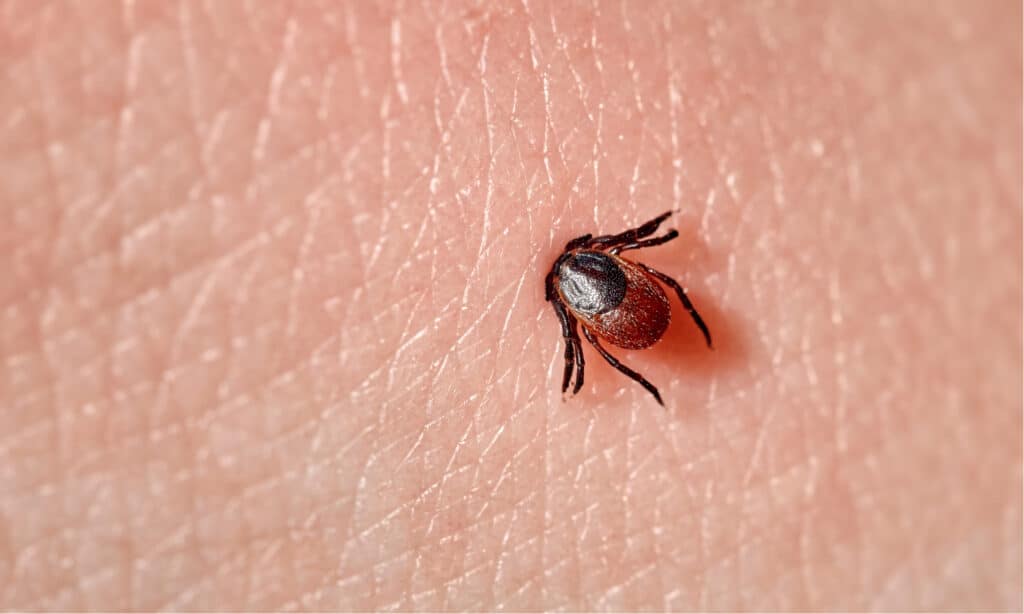
Ticks are larger in size than fleas and can grow even larger as they feed on their host.
©Evgeniyqw/Shutterstock.com
The size of an adult flea is about 1/8th of an inch. This makes them about as big as a pin. They’re so tiny that you won’t be able to see most of the details of the flea’s appearance unless you have a microscope. You can see adult fleas with your naked eye, but they typically appear as brown specks in hair, fur, and clothing. These brown spots, however, may not actually be fleas themselves, but rather flea dirt. A flea’s feces is what makes up flea dirt.
On the other hand, ticks tend to be larger than fleas. There are various colors of ticks, including black, red, brown, yellowish, and grey. They belong to the arachnid family and have round bodies and eight legs. Although their legs are often masked by their round bodies, particularly when they’re well-fed. Whenever a tick feeds on a host, the size of its body increases greatly, sometimes growing as large as a grape.
Fleas vs. Ticks: How They Move Around
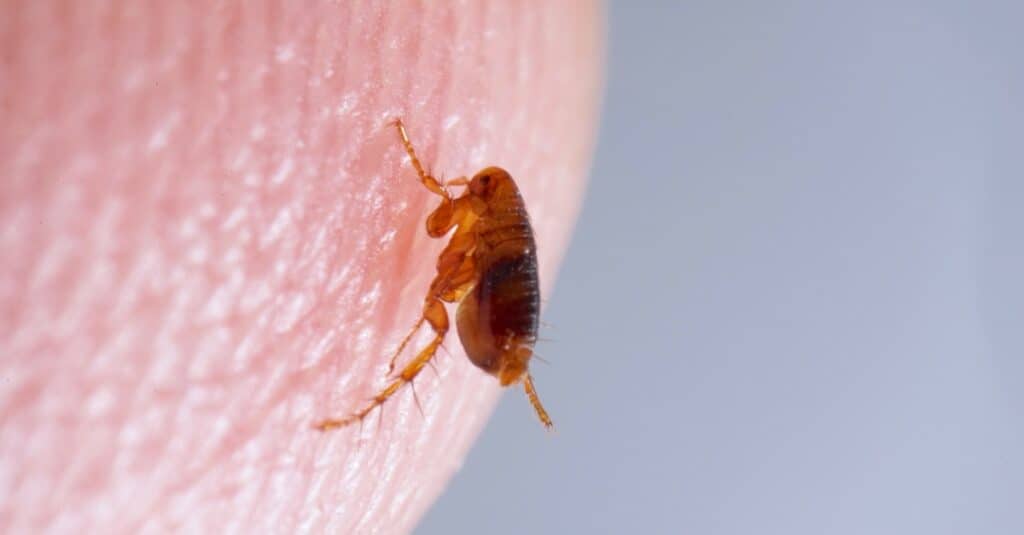
Unlike ticks, fleas are capable of jumping great distances and can even soar.
©iStock.com/S.Rohrlach
Despite the fact that the flea lacks wings, it is an excellent jumper. It is not until the number of fleas reaches a threshold that infestations are detected because of flea size. The most common symptom of this is the appearance of thousands of small, brown spots on a dog or cat all at once. Your pets will begin scratching themselves a lot and you may begin to see these small brown spots show up on your rug and around your home.
A tick has no wings as well. Several methods have been used by these insects to find a host, including crawling, climbing, balancing, or even hanging from loose objects. Feeding occurs when they finally latch onto their host. It is no secret that they are resourceful, persistent, and clever when it comes to finding their hosts. It is common for them to latch on during times when prey is most vulnerable. Most often when they are sleeping, resting, or immobile in some way.
Fleas vs. Ticks: Behavioral Characteristics
Fleas prefer to live in the fur of one warm-blooded animal. This is because they have an endless supply of food, and sleep, and are able to reproduce with ease. Female fleas can lay 50 eggs at a time, which makes for a lot of irritating bites for their hosts. It is believed that one flea can eat fifteen times its body weight in one day. Indoor flea infestations are usually caused by household pets, and fleas are commonly found infesting both pets and residences.
As far as finding food and shelter is concerned, ticks are very different from fleas. Instead of sticking to one host, ticks move around from body to body. If there is no warm-blooded host to latch onto, a tick will unlatch and drop to the ground to lay eggs, find a mate, or await another host. In fact, ticks can wait for anything. They can wait for weeks between meals and there is nothing that they cannot wait for. People and animals who spend a lot of time outdoors are more likely to get infected with ticks. Even though ticks are small, they have the ability to attach themselves to socks, collars, shoes, and even hair for hours before being spotted.
Disease Symptoms of Fleas and Ticks
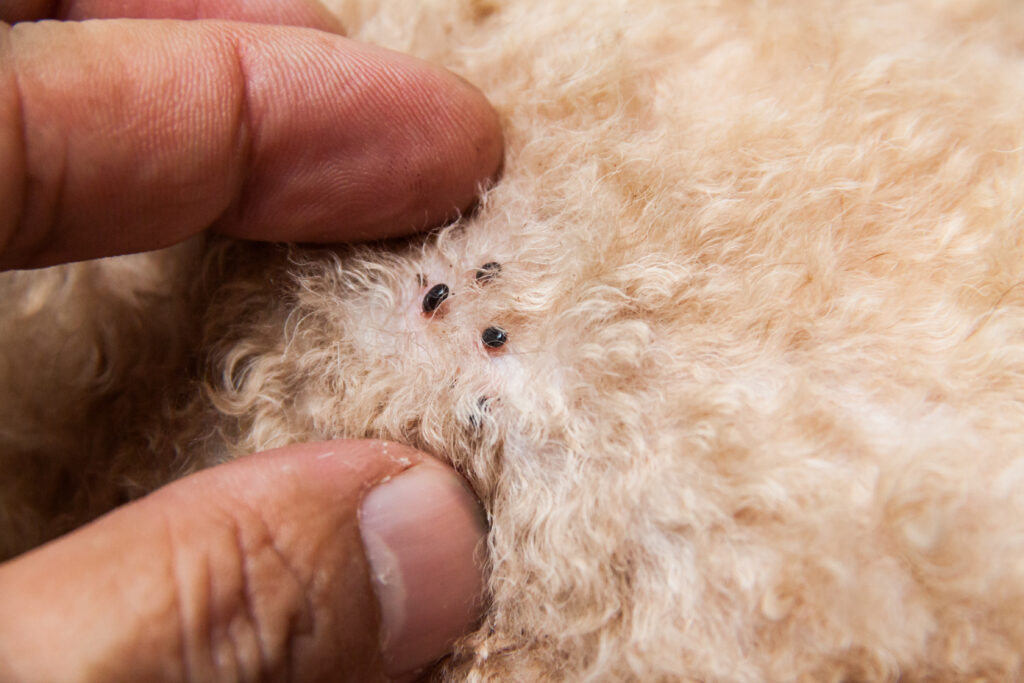
Both fleas and ticks are capable of spreading diseases to your pets.
© ThamKC/Shutterstock.com
It is important to note that both fleas and ticks can spread diseases easily. You must be aware of the symptoms of a bite from these parasites if you wish to prevent serious health issues. Let’s take a look at the difference between the diseases spread by fleas and ticks and the symptoms associated with them.
Diseases Fleas Carry
There are relatively few flea-borne diseases in the United States. However, with an increase in international travel in recent years and the possibility of higher temperatures in the near future, more people can become infected.
- Murine Typhus: This disease is caused by a bacteria called Rickettsia typhi, which is spread by fleas. A flea carries flea-borne typhus and spreads it to people when they come into contact with it. The disease is rare in North America but has severe consequences.
- Bubonic Plague: Rats carry and transmit the plague, which is transmitted to people and pets through flea bites. A plague-infected flea can also be carried into the house by pets like dogs and cats. Symptoms included fever, weakness, chills, and swollen lymph nodes.
- Dipylidium Infection: It is possible for dogs and cats to accidentally ingest adult fleas infected with tapeworms. In the process of self-grooming, dogs and cats can swallow fleas that are infected with tapeworms.
Diseases Ticks Carry
The tick is a blood-sucking parasite. When you or your pet are bitten by a tick, you may be exposed to one or more types of bacteria or viruses. A number of symptoms may develop weeks, months, or years after being infected if these infections go untreated.
- Lyme Disease: A bacterium named Borrelia burgdorferi or Borrelia mayonii causes Lyme disease. An infected black-legged tick bite spreads the virus to humans. There might be fever, joint pain, swelling, and swelling around the nodes in the neck area if you have this infection.
- Rocky Mountain spotted fever: Usually caused by a tick that is infected with the rickettsia group of bacteria, Rocky Mountain spotted fever is a potentially fatal disease. There are several symptoms of this illness, including fever, headache, and muscle aches. At the site of a tick bite, you may experience a rash, often with blackened or crusted skin.
- Babesiosis: Infected ticks carrying Babesia microti are the cause of this rare, sometimes deadly disease. A large percentage of Babesia microti-infected people do not have any symptoms. There are some people who develop general flu symptoms including fever and chills.
- Southern Tick-Associated Rash Illness: Humans have been reported to develop a rash similar to Lyme disease after being bitten by the lone star tick, Amblyomma americanum. There may be fatigue, fever, headaches, muscle and joint pain in addition to the rash.
What Are Some Ways to Prevent Fleas or Ticks?
Are you worried about fleas and ticks infesting your pets or biting you? Well, you’re not the only one. Although fleas and ticks are much more likely to latch onto an animal host than people, that doesn’t mean you’re safe from getting infected. There are several topical solutions available through pet stores and veterinarian’s offices that deter the spread of fleas and ticks. In order to prevent fleas and ticks from infesting your pet’s body, you can use preventative shampoos, oral supplements, and topical solutions.
Stay away from places where ticks are known to be present when spending time outdoors. Stay away from branches and brush where ticks might be hiding, waiting for a host, when adventuring outside, wearing clothing that conceals your arms and legs. It is also a good idea to apply a bug repellent containing DEET in order to keep ticks at bay. Check yourself and your family for ticks after returning from an outing, since the longer a tick is left to feed, the higher the likelihood of harmful pathogen exposure.
It is also important to keep your yard clean and tidy along with your house. Maintaining a regular lawn mowing schedule, raking leaves, and removing brush clippings from your yard will help prevent fleas from hanging out and breeding in your yard. High grasses tend to be a breeding ground for ticks, so try and reduce them.
The photo featured at the top of this post is © iStock.com/digitalg
Thank you for reading! Have some feedback for us? Contact the AZ Animals editorial team.





